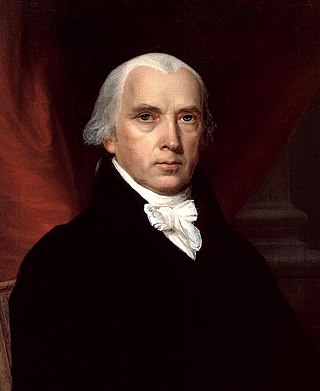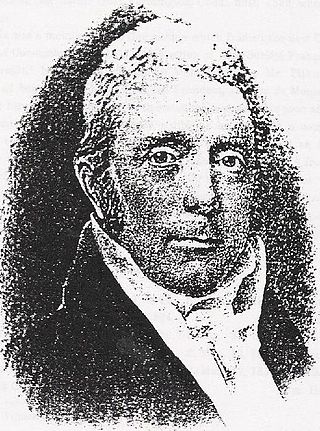Related Research Articles

The Quasi-War was an undeclared naval war fought from 1798 to 1800 between the United States and the French First Republic, primarily in the Caribbean and off the East Coast of the United States.

Samuel Finley Breese Morse was an American inventor and painter. After having established his reputation as a portrait painter, in his middle age Morse contributed to the invention of a single-wire telegraph system based on European telegraphs. He was a co-developer of Morse code in 1837 and helped to develop the commercial use of telegraphy.

The Federalist Party was a conservative and nationalist American political party and the first political party in the United States. Under Alexander Hamilton, it dominated the national government from 1789 to 1801. Defeated by the Democratic-Republican Party in 1800, it became a minority party while keeping its stronghold in New England and made a brief resurgence by opposing the War of 1812. It then collapsed with its last presidential candidate in 1816. Remnants lasted for a few years afterwards. The party appealed to businesses and to conservatives who favored banks, national over state government, manufacturing, an army and navy, and in world affairs preferred Great Britain and strongly opposed the French Revolution. The party favored centralization, federalism, modernization, industrialization, and protectionism.

The War of 1812 was fought by the United States of America and its indigenous allies against the United Kingdom and its own indigenous allies in British North America, with limited participation by Spain in Florida. It began when the United States declared war on 18 June 1812. Although peace terms were agreed upon in the December 1814 Treaty of Ghent, the war did not officially end until the peace treaty was ratified by Congress on 17 February 1815.

The 1812 United States presidential election was the seventh quadrennial presidential election. It was held from Friday, October 30, 1812 to Wednesday, December 2, 1812. Taking place in the shadow of the War of 1812, incumbent Democratic-Republican President James Madison defeated DeWitt Clinton, the Lieutenant Governor of New York and Mayor of New York City, who drew support from dissident Democratic-Republicans in the North as well as Federalists. It was the first presidential election to be held during a major war involving the United States.

The Treaty of Amity, Commerce, and Navigation, Between His Britannic Majesty and the United States of America, commonly known as the Jay Treaty, and also as Jay's Treaty, was a 1794 treaty between the United States and Great Britain that averted war, resolved issues remaining since the Treaty of Paris of 1783, and facilitated ten years of peaceful trade between the United States and Britain in the midst of the French Revolutionary Wars, which began in 1792. The Treaty was designed by Alexander Hamilton and supported by President George Washington. It angered France and bitterly divided Americans. It inflamed the new growth of two opposing parties in every state, the pro-Treaty Federalists and the anti-Treaty Jeffersonian Republicans.

José Gervasio Artigas Arnal was a soldier and statesman who is regarded as a national hero in Uruguay and the father of Uruguayan nationhood.

Charles Cotesworth Pinckney was an American statesman, military officer and Founding Father who served as United States Minister to France from 1796 to 1797. A delegate to the Constitutional Convention where he signed the Constitution of the United States, Pinckney was twice nominated by the Federalist Party as its presidential candidate in 1804 and 1808, losing both elections.

Henry Lee III was an early American Patriot and U.S. politician who served as the ninth Governor of Virginia and as the Virginia Representative to the United States Congress. Lee's service during the American Revolution as a cavalry officer in the Continental Army earned him the nickname by which he is best known, "Light-Horse Harry". He was the father of Robert E. Lee, who led the Army of Northern Virginia against the Union Army during the American Civil War.

The postage stamps and postal system of the Confederate States of America carried the mail of the Confederacy for a brief period in American history. Early in 1861 when South Carolina no longer considered itself part of the Union and demanded that the U.S. Army abandon Fort Sumter, plans for a Confederate postal system were already underway. Indeed, the Confederate Post Office was established on February 21, 1861; and it was not until April 12 that the American Civil War officially began, when the Confederate Army fired upon US soldiers who had refused to abandon the fort. However, the United States Post Office Department continued to handle the mail of the seceded states as usual during the first weeks of the war. It was not until June 1 that the Confederate Post Office took over collection and delivery, now faced with the task of providing postage stamps and mail services for its citizens.

A blockade runner is a merchant vessel used for evading a naval blockade of a port or strait. It is usually light and fast, using stealth and speed rather than confronting the blockaders in order to break the blockade. Blockade runners usually transport cargo, for example bringing food or arms to a blockaded city. They have also carried mail in an attempt to communicate with the outside world.

This article covers the history of the United States from 1789 through 1849, the period of westward expansion.

Caleb Strong was an American lawyer, politician, and Founding Father who served as the sixth and tenth governor of Massachusetts between 1800 and 1807, and again from 1812 until 1816. He assisted in drafting the Massachusetts State Constitution in 1779 and served as a state senator and on the Massachusetts Governor's Council before being elected to the inaugural United States Senate. A leading member of the Massachusetts Federalist Party, his political success delayed the decline of the Federalists in Massachusetts.

Thomas Jefferson served as the third president of the United States from March 4, 1801, to March 4, 1809. Jefferson assumed the office after defeating incumbent John Adams in the 1800 presidential election. The election was a political realignment in which the Democratic-Republican Party swept the Federalist Party out of power, ushering in a generation of Jeffersonian Republican dominance in American politics. After serving two terms, Jefferson was succeeded by Secretary of State James Madison, also of the Democratic-Republican Party.
The results of the War of 1812, which was fought between the United Kingdom and the United States from 1812 to 1814, included no immediate boundary changes. The main result of the War of 1812 has been over two centuries of peace between the two countries.

Opposition to the War of 1812 was widespread in the United States, especially in New England. Many New Englanders opposed the conflict on political, economic, and religious grounds. When the Embargo Act of 1807 failed to remedy the situation with the United Kingdom, with Britain refusing to rescind the Orders in Council (1807) and the French continuing their decrees, certain Democratic-Republicans known as war hawks felt compelled to persuade the United States government to declare war on the British. A number of contemporaries called it, "The second war for independence." Henry Clay and John Calhoun pushed a declaration of war through Congress, stressing the need to uphold American honor and independence. Speaking of the impact of the depressed cotton trade upon his fellow Southerners, Calhoun told Congress that:

The Federalist Era in American history ran from 1788 to 1800, a time when the Federalist Party and its predecessors were dominant in American politics. During this period, Federalists generally controlled Congress and enjoyed the support of President George Washington and President John Adams. The era saw the creation of a new, stronger federal government under the United States Constitution, a deepening of support for nationalism, and diminished fears of tyranny by a central government. The era began with the ratification of the United States Constitution and ended with the Democratic-Republican Party's victory in the 1800 elections.

The North Somerset Yeomanry was a part-time cavalry regiment of the British Army from 1798 to 1967. It maintained order in Somerset in the days before organised police forces, and supplied volunteers to fight in the Second Boer War. It served on the Western Front in the First World War. At the outbreak of the Second World War, it continued to operate in the mounted role and then as a specialist signals unit. Postwar it joined the Royal Armoured Corps and later became infantry. Its lineage today is maintained by 93 Squadron 39 (Skinners) Signal Regiment.
The Confederate privateers were privately owned ships that were authorized by the government of the Confederate States of America to attack the shipping of the United States. Although the appeal was to profit by capturing merchant vessels and seizing their cargoes, the government was most interested in diverting the efforts of the Union Navy away from the blockade of Southern ports, and perhaps to encourage European intervention in the conflict.

Blue light is an archaic signal, the progenitor of modern pyrotechnic flares. Blue light consists of a loose, chemical composition burned in an open, hand-held hemispherical wooden cup, and so is more akin to the flashpan signals of the Admiral Nelson era than the modern, encased signal flares, which are often launched by mortar or rifle and suspended by parachute. Widely used during the eighteenth and nineteenth centuries for signaling by the world's military forces, and for general illumination in the civilian sector, blue light was remarkable for its use of poisonous arsenic compounds, which contributed to its replacement by safer flares in the early twentieth century.